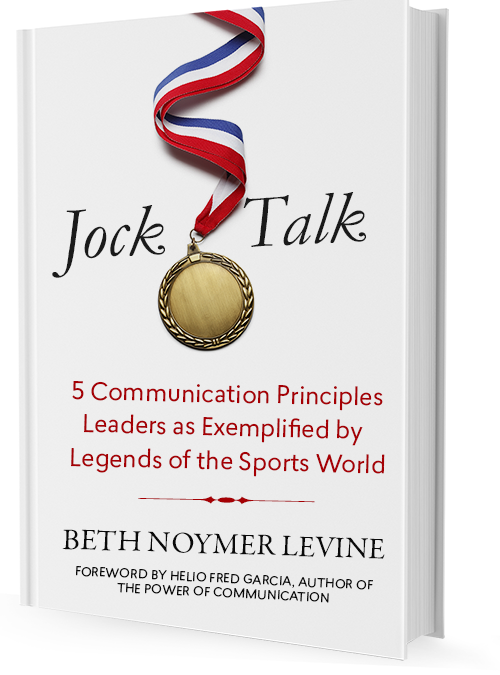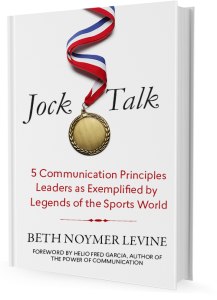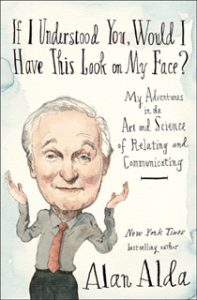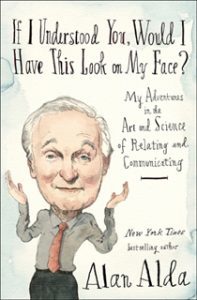
by Beth Levine | Oct 12, 2021 | public speaking
 It doesn’t take much to be a good leader-communicator. Perfection may be elusive, but being good enough to earn the admiration of your team are well within reach. Adherence to a few core principles takes care of most situations.
It doesn’t take much to be a good leader-communicator. Perfection may be elusive, but being good enough to earn the admiration of your team are well within reach. Adherence to a few core principles takes care of most situations.
In my book Jock Talk: 5 Communication Principles for Leaders as Exemplified by Legends of the Sports World, I walk readers through the philosophy behind, and application of, these 5 principles: Audience-centricity, Transparency, Graciousness, Brevity, and Preparedness.
Taken together, they send two really important messages about you to your audience: 1) that you care about and respect them, and 2) that you’re real and therefore credible and trustworthy.
Audience-centricity is probably the most fundamental of the five principles. Simply put, audience-centricity is making the audience’s interests and experience a top priority in the planning and execution of a talk. Too many speakers prepare and deliver what is important and interesting to themselves without enough careful consideration of their listeners. Being audience-centric is a mindset shift that encourages the speaker to prepare and deliver content in a way that will matter to and resonate with the audience.
Transparency is exactly what you think it is; it’s about being open and direct—yes, and honest, too. Transparency is critical. It contributes to the levels of sincerity and trust that are accorded to you by your audience.
Graciousness is the art, skill, and willingness to be kindhearted, fair, and polite. As motivators and influencers, love and peace work far better than hate and war. Speaking in positives rather than negatives leaves lasting, favorable impressions.
Brevity is a crowd-pleaser and needs no further introduction.
Preparedness speaks for itself as well, especially because the unprepared speaker is the one who is most likely to be longwinded, not to mention unfocused. While the mere thought of preparation might bring on feelings of dread or even impossibility, there are ways to prepare that take only seconds but that can greatly enhance a speaker’s effectiveness.
As you settle in for the homestretch toward year-end, I would encourage you to pick one of these principles as your personal pet project for the remainder of Q4. Which one of these 5 do you feel like you need to improve on the most? Or which one of these 5 would have the most impact on your business if you strengthened it? Pick one and go for it!

by Beth Levine | Aug 25, 2020 | preparing for a presentation, public speaking
 How many times have you said, when asked about an upcoming presentation, “Gosh, I hope it goes well!”?
How many times have you said, when asked about an upcoming presentation, “Gosh, I hope it goes well!”?
Think about that for a moment. You hope it goes well? What’s the plan that goes with that?
Hope is not a strategy. A plan to deploy your knowledge and skills is a strategy. Let’s break this down in the simplest way possible:
Your knowledge. You have a topic, and you have subject-matter expertise in that topic. That’s great, but still not enough. The next ingredient in planning your presentation is audience-centricity – taking into account your audience’s interests, needs and experience. In other words, you must organize and prepare your topic/expertise in a way that presents compelling points to your audience, and you must choreograph your time taking into account things like work-from-home distractions and screen-fatigue.
Your skills. You’re a decent presenter when you’re face to face with your audience, i.e. in the same room. More than likely, though, you’re going to need to be just as effective delivering virtually. You’ll need energy – more than usual – in your voice and body. Keep your voice energy consistently up and animated. Sit up straight and be forward in your chair. You’ll also need to employ intense eye contact – with the little green light that is the camera on your computer. Speak to the camera so that your audience sees you looking at them. And you’ll need to rehearse all of this because, in so many ways, it’s trickier than presenting face-to-face.
As we near the end of summer, and continue to settle into the new realities of how we do business, this is a good time to refresh our mindset about making effective presentations. To that end, keep in mind: Hope is not a strategy. Preparation is.
by Beth Levine | Jul 10, 2019 | Just Mouthing Off, public speaking
 I’m so proud of my client! Let’s call him John.
I’m so proud of my client! Let’s call him John.
Over the past three months, John has been successful in adapting his communication style and effectiveness so much that it’s noticeable to (and appreciated by) his colleagues and superiors. Quite simply, he has started to use inquiry + listening for understanding before disagreeing or talking.
John is passionate about his work. He’s also incredibly smart. However, he had been getting mixed feedback about his communication style in meetings. Seems that some of his colleagues felt he talked too much and took too long get his thoughts out. Others believed he was thoughtful and measured and thorough. (Long-windedness is apparently in the ear of the beholder!) He was confused and frustrated, unsure of how opinions (gathered in a 360 performance appraisal) could be so divergent.
His boss reached out to me, hoping I might be able to help him communicate in a way that is more collegial and concise. She told me John is a highly skilled and valued manager, but that his style in meetings verged on pontificating and many found it overbearing. She had talked to him about it, and they agreed to get him some coaching.
Luckily, John was super self-aware and also motivated to improve. When we began working together, he and I dove into why and how he tended to make his longer, more involved points during meetings. Turns out, it came from a sincere place – his passion for his organization’s work and his drive to achieve good outcomes. Fair enough. What we worked on was basically audience-centricity, or putting the audience first. We did that in three ways:
- Using inquiry: Asking questions of other people so he could draw out context, examples and perspective. It helps avoid misunderstandings and makes others feel as though they’ve been heard. Inquiry surfaces material for better, more informed dialogue and decision-making.
- Listening for understanding … versus listening for responding: Being open and empathetic in how he pays attention to other speakers in the room. Most of us listen with only half an ear; the other half is busy formulating or finessing a response. Listening for understanding requires that you stop composing your response or put aside thoughts of responding until after you’ve assimilated what the speaker has said.
- Disagreeing diplomatically: Offering up an opposing view in a constructive way on those occasions when John disagreed with what he was hearing. This involves a combination of 1) repeating what you heard and understood from others to be sure you got it right, and 2) articulating the shared opinions or shared goals you have with the other speaker(s). After those two steps, which empathize and build connection, you are free to share your view.
Just like the old saying, “look before you leap,” you should also think before you talk. You may have a strong position or a lot to say, but your colleagues and clients want and need to be heard and understood first. It’s all about them, your audience, because you can’t and won’t achieve your goals without them.

by Beth Levine | Aug 13, 2018 | preparing for a presentation, public speaking
It doesn’t take much to be a good leader-communicator. Perfection may be elusive, but being good enough to earn the admiration of your team are well within reach. Adherence to a few core principles takes care of most situations.
 In my book Jock Talk: 5 Communication Principles for Leaders as Exemplified by Legends of the Sports World, I walk readers through the philosophy behind, and application of, these 5 principles: Audience-centricity, Transparency, Graciousness, Brevity, and Preparedness.
In my book Jock Talk: 5 Communication Principles for Leaders as Exemplified by Legends of the Sports World, I walk readers through the philosophy behind, and application of, these 5 principles: Audience-centricity, Transparency, Graciousness, Brevity, and Preparedness.
Taken together, they send two really important messages about you to your audience: 1) that you care about and respect them, and 2) that you’re real and therefore credible and trustworthy.
Audience-centricity is probably the most fundamental of the five principles. Simply put, audience-centricity is making the audience’s interests and experience a top priority in the planning and execution of a talk. Too many speakers prepare and deliver what is important and interesting to themselves without enough careful consideration of their listeners. Being audience-centric is a mindset shift that encourages the speaker to prepare and deliver content in a way that will matter to and resonate with the audience.
Transparency is exactly what you think it is; it’s about being open and direct—yes, and honest, too. Transparency is critical. It contributes to the levels of sincerity and trust that are accorded to you by your audience.
Graciousness is the art, skill, and willingness to be kindhearted, fair, and polite. As motivators and influencers, love and peace work far better than hate and war. Speaking in positives rather than negatives leaves lasting, favorable impressions.
Brevity is a crowd-pleaser and needs no further introduction.
Preparedness speaks for itself as well, especially because the unprepared speaker is the one who is most likely to be longwinded, not to mention unfocused. While the mere thought of preparation might bring on feelings of dread or even impossibility, there are ways to prepare that take only seconds but that can greatly enhance a speaker’s effectiveness.
As summer winds down and everyone settles in for the homestretch toward year-end, I would encourage you to pick one of these principles as your personal pet project for the fall. Which one of these 5 do you feel like you need to improve on the most? Or which one of these 5 would have the most impact on your business if you strengthened it? Pick one and go for it!

by Beth Levine | Apr 2, 2018 | preparing for a presentation, public speaking
Are you a communicator or a broadcaster?
Are you more inclined to participate in a dialogue or engage in a competing monologue?
Are you someone who listens to learn and appreciate or who listens to find a springboard to something you wanted to say?
The two-way street of communicating has many subtle nuances that – if I’m honest about this – are not sufficiently addressed in communication or presentation skills trainings. This is perhaps due to the many nuances or to their subtleties, which are highly individualized, depending on variations in people and situations, and therefore impossible to fully anticipate.
Nonetheless, in communication and presentation skills trainings, we tend to be more consumed with the command and impressiveness of the speaker than we are with the speaker’s ability to relate – to listen, appreciate, empathize and respond appropriately. We are focused on the performance side – the broadcasting, the competing monologue – more than the relating side. And when I say “we,” I’m talking about both trainer/coach and speaker. We both could do better.
 In Alan Alda’s book If I Understood You, Would I Have This Look on My Face?, he writes: “There’s a body of scientific literature on responsive listening, but I came to understand it in a personal way through my work. In acting, this kind of relating is fundamental. You don’t say your next line simply because it’s in the script. You say it because the other person has behaved in a way that makes you say it. Relating to them allows them to have an effect on you – to change you, in a way. And that’s why you respond the way you do.
In Alan Alda’s book If I Understood You, Would I Have This Look on My Face?, he writes: “There’s a body of scientific literature on responsive listening, but I came to understand it in a personal way through my work. In acting, this kind of relating is fundamental. You don’t say your next line simply because it’s in the script. You say it because the other person has behaved in a way that makes you say it. Relating to them allows them to have an effect on you – to change you, in a way. And that’s why you respond the way you do.
You don’t say your next line simply because it’s in the script. Wow. If you’re relating, then you need to remain open to ditching your proverbial script and to being affected, influenced even, by the other person’s words or point of view. This requires no anticipation and preparation; it merely requires being present, yielding, and genuinely leaning in and listening.
When I talk about “audience-centricity” in my trainings, it falls a little short of Alda’s responsive listening. I encourage speakers to prepare for meetings and presentations in a way that puts the audience’s needs, interests and experience ahead of their own. So yes, yielding to the audience and putting them first is important. It’s a start.
Then there’s also what I call “dynamic listening” – paying attention to your audience with all five senses. Watching, listening, sensing whether they’re with you, understanding you, energized or not. This is yet another step. But both of these – audience-centricity and dynamic listening – overlook the actual response side of the two-way street.
Relating, as Alda suggests, takes it to the finish line. It requires, as improv comedy does, that you open yourself to the words and reactions of others so that then, and only then, can you respond in a meaningful, relevant, relatable way.
The script is necessary; there’s no question you should always be prepared. But your next line, your response to a client or stakeholder, does not necessarily have to come from the script. It can come from the place of empathy and appreciation that you keep open in your eyes, ears, mind and heart.

 It doesn’t take much to be a good leader-communicator. Perfection may be elusive, but being good enough to earn the admiration of your team are well within reach. Adherence to a few core principles takes care of most situations.
It doesn’t take much to be a good leader-communicator. Perfection may be elusive, but being good enough to earn the admiration of your team are well within reach. Adherence to a few core principles takes care of most situations.

 How many times have you said, when asked about an upcoming presentation, “Gosh, I hope it goes well!”?
How many times have you said, when asked about an upcoming presentation, “Gosh, I hope it goes well!”?  I’m so proud of my client! Let’s call him John.
I’m so proud of my client! Let’s call him John. 





